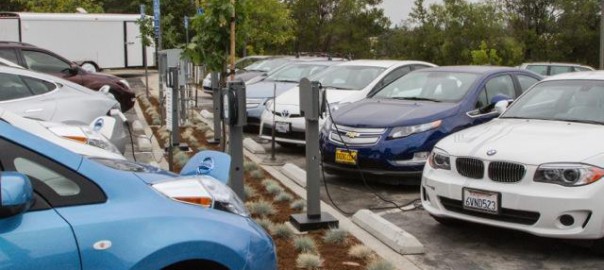Many companies are considering providing workplace charging for their employees and finding they are in new territory with many options to consider. We at Plug In America would like to share what we have learned having been involved for over 10 years in both using charging infrastructure as drivers and advising site hosts of all types in how to provide effective charging facilities.
Goals
There are many reasons a company may be considering providing workplace charging. It could be to attract and retain forward-thinking employees, to enhance a company’s “green” image, to gain points toward LEED certification, or to raise awareness of electric vehicles.
Our analysis and recommendations are based on the goal of using workplace charging to increase the adoption of electric vehicles, which ties in with many of the reasons we find companies are considering making charging available in the workplace. Even when this is not an explicit goal at a given company, understanding the issues presented here may be helpful in evaluating charging options.
We also want to minimize the cost to the employer while meeting the goal of encouraging increased use of electric vehicles. These considerations include infrastructure costs, operating costs, maintenance costs, and efficient use of employee time.
There is certainly no one-size-fits-all approach that meets the goals and needs of every company. The ideas presented here are meant to serve as a starting point, a baseline plan that can be used to inform the analysis of corporate goals, infrastructure considerations, and employee interests.
Terminology
Level 1 refers to charging at 120V. This can be from an ordinary outlet using a portable charging device or from a dedicated Level 1 station that has the proper electronics and plug to connect directly to a plug-in electric vehicle. For long term loads, like charging a vehicle, the current drawn is generally limited to 12A, which yields 1.44 kilowatts (kW) of charging.
Level 2 refers to charging at higher voltage, 208V to 240V. This can also done from a 240V outlet (NEMA 14-50, for example) using a charging cord, but is more typically done with a dedicated charging station. The current limit for these stations is typically 30 to 32 amps (~7 kW), but can be anything from 15A to 80A (up to 19.2 kW).
DC Quick Charge This charging method bypasses the vehicle’s on-board AC charging equipment and sends high voltage (300V to 400V) DC directly to the battery, at rates between 20 and 130 kW. These are expensive to install and operate, and are typically used for road trips or other situations where extra charge is needed in a hurry, not for a workday charging session.
The “Just Right” Fee
Problem: Free Reduces Availability
Free charging sounds like the best incentive to get people to consider electric vehicles, but the cost of electricity is not a barrier to EV adoption. An exact comparison with gas depends on a number of factors, but think of driving on electricity as equivalent to getting gas for less than $1 per gallon. Free charging makes the cost benefit more apparent, but has a couple of problems. First, it sets an expectation that charging will always be free, something that generally isn’t sustainable. A short-term pilot with free charging can be very effective in kickstarting awareness of electric vehicles, and some companies may want to continue to provide free charging even as EVs rise in popularity.
However, if free charging drives demand to a level that can’t be met, the resulting oversubscription can create problems that reduce EV adoption. Free charging motivates everyone to charge at work because it’s cheaper than charging at home. Charging that is oversubscribed is undependable and therefore people who can’t charge at home won’t find it a viable option. The only people who can use free charging are those who don’t need it because they have a more reliable alternative. This creates conflict between drivers who need charging to get home and others who just want to charge because it’s free. This built-in conflict can even create a hostile environment at work. Who wants to get into a shouting match over fueling their car so they can get home?
When free charging leads to oversubscription and reduces charging availability for those who need to charge, it discourages EV adoption among those who could most benefit from charging at work.
Problem: Overly Cheap Charging Shifts Off-Peak Use to On-Peak
Like free charging, billing at a rate that’s below the market price for electricity incentivizes shifting charging from overnight at home to charging at work during the day. As EV adoption increases, this puts extra strain on the grid and increases energy costs.
Problem: Overly Expensive Charging Can Hurt Adoption Or Usage
Paid charging billed far above the cost of electricity erases the economic advantage of driving electric. People who can’t charge at home thus can’t use this as a way to make driving electric financially viable. This therefore will not increase EV adoption. Likewise it can’t substantially increase use of EVs if it makes driving electric cost more than burning gas.
Solution: Charge a Little Over Market Price
The solution is to provide charging billed at just a little above local home rates. This extends the economic advantages of driving electric to those who cannot charge at home. It also eliminates the incentive to shift charging from home to work, reducing the number of stations needed to satisfy demand. Together these benefits minimize the infrastructure cost of providing charging at work and focus the benefits on those who need it the most.
Note that billing for public charging is different; other issues are at play there.
Read more: Plug In America
